CLIMATE CHANGE 2022: MITIGATION OF CLIMATE CHANGE (Intergovernmental Panel on Climate Change, IPCC)
Article
This report is about taking action. It is about mitigating the effects. Climate change will not be stopped even if we cut emissions overnight at this point. So, this report focuses on managing our resources. Negotiations in this case are realism needed to act.
What this report is done is to show how taking action now can move us towards a fairer and more livable world.
CLIMATE CHANGE 2022: MITIGATION OF CLIMATE CHANGE (4 Apr. 2022)
The Working Group III (IPCC) 2,913pages
https://www.ipcc.ch/report/sixth-assessment-report-working-group-3/
https://www.ipcc.ch/report/ar6/wg3/ 
Mitigation of Climate Change 2022
Key findings showing where we are in terms of greenhouse gas emissions, where we're headed and what action we can take to limit global warming. Now the reality is that greenhouse gasses emissions which are causing global warming or at their highest levels in human history.
Emissions in 2019. About 12% higher than they were in 2010 and 54% higher than in 1990. So we are definitely not on track to limit warming to 1.5 degrees Celsius, but there is increased evidence of climate action and the average annual rate of growth.
Global emissions have slowed in the last decade from 2.1% per year in the early part of this century to 1.3% per year between 2010 and 2019. And this decline in growth is particularly noticeable in the energy and industry sectors, where the rate of growth has more than halved.
Despite this progress, our assessment concludes that unless there are immediate and deep emission reductions across all sectors, limiting warming to 1.5 degrees will be beyond reach.
Some countries have achieved a steady decrease in emissions over several years at rates consistent with limiting warming to 2 degrees and a growing number of cities are setting net zero targets and an increased range of policies and laws have enhanced energy efficiency, reduced rates of deforestation, and accelerated the deployment of renewable energy and climate laws. That result in reduced or avoided emissions are present in 56 countries covering more than half of global emissions.
Emissions in 2019. About 12% higher than they were in 2010 and 54% higher than in 1990. So we are definitely not on track to limit warming to 1.5 degrees Celsius, but there is increased evidence of climate action and the average annual rate of growth.
Global emissions have slowed in the last decade from 2.1% per year in the early part of this century to 1.3% per year between 2010 and 2019. And this decline in growth is particularly noticeable in the energy and industry sectors, where the rate of growth has more than halved.
Despite this progress, our assessment concludes that unless there are immediate and deep emission reductions across all sectors, limiting warming to 1.5 degrees will be beyond reach.
Some countries have achieved a steady decrease in emissions over several years at rates consistent with limiting warming to 2 degrees and a growing number of cities are setting net zero targets and an increased range of policies and laws have enhanced energy efficiency, reduced rates of deforestation, and accelerated the deployment of renewable energy and climate laws. That result in reduced or avoided emissions are present in 56 countries covering more than half of global emissions.
One notable success is around renewable energy. Since 2010, there have been sustained decreases in unit costs, with reductions of 85% for solar energy, 55% for wind power and 85% for batteries, and in some cases, costs have fallen below those of fossil fuels.
And at the same time, we've seen big increases in installed capacity.
Looking at policies that were implemented by December 2020, we conclude that without strengthening mitigation efforts, greenhouse gas emissions are projected to lead to warming of 3.2 degrees in the scenarios we assessed.
Limiting warming to 1.5 degrees requires global greenhouse gas emissions to peak before 2025 at the latest. And be reduced by 43% by 2030. Emissions from methane, a short lived but very potent greenhouse gas, would also need to be reduced by about a third.
Over the same period, and even if we do this, it is almost inevitable that we will at least temporarily exceed 1.5 degrees warming. But we could return below this level by the end of the century.
Limiting warming to around 2 degrees still requires global emissions to peak before 2025 at the latest, to be reduced by about a quarter by 2030. The temperature will stabilize when we reach net zero carbon dioxide emissions. So to limit warming to around 1.5 degrees requires reaching net zero carbon dioxide emissions in the early 2050.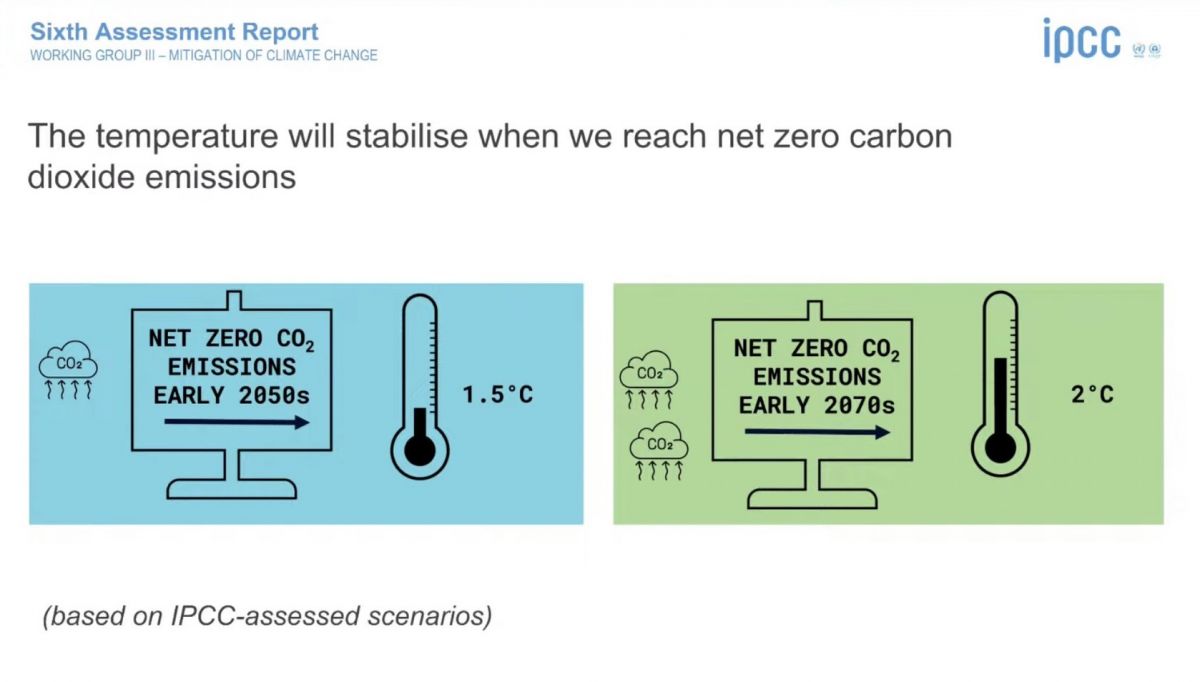
And for 2 degrees carbon dioxide emissions. We'd have to be reduced to net zero. In the early 2070, deep and sustained reductions of other gasses would also be required. So how do we go about reducing these emissions?
The options that are available in each sector to combat climate change.
In every sector there are options available that can at least have emissions by 2030 and keep open the possibility of limiting warming to 1.5 degrees.
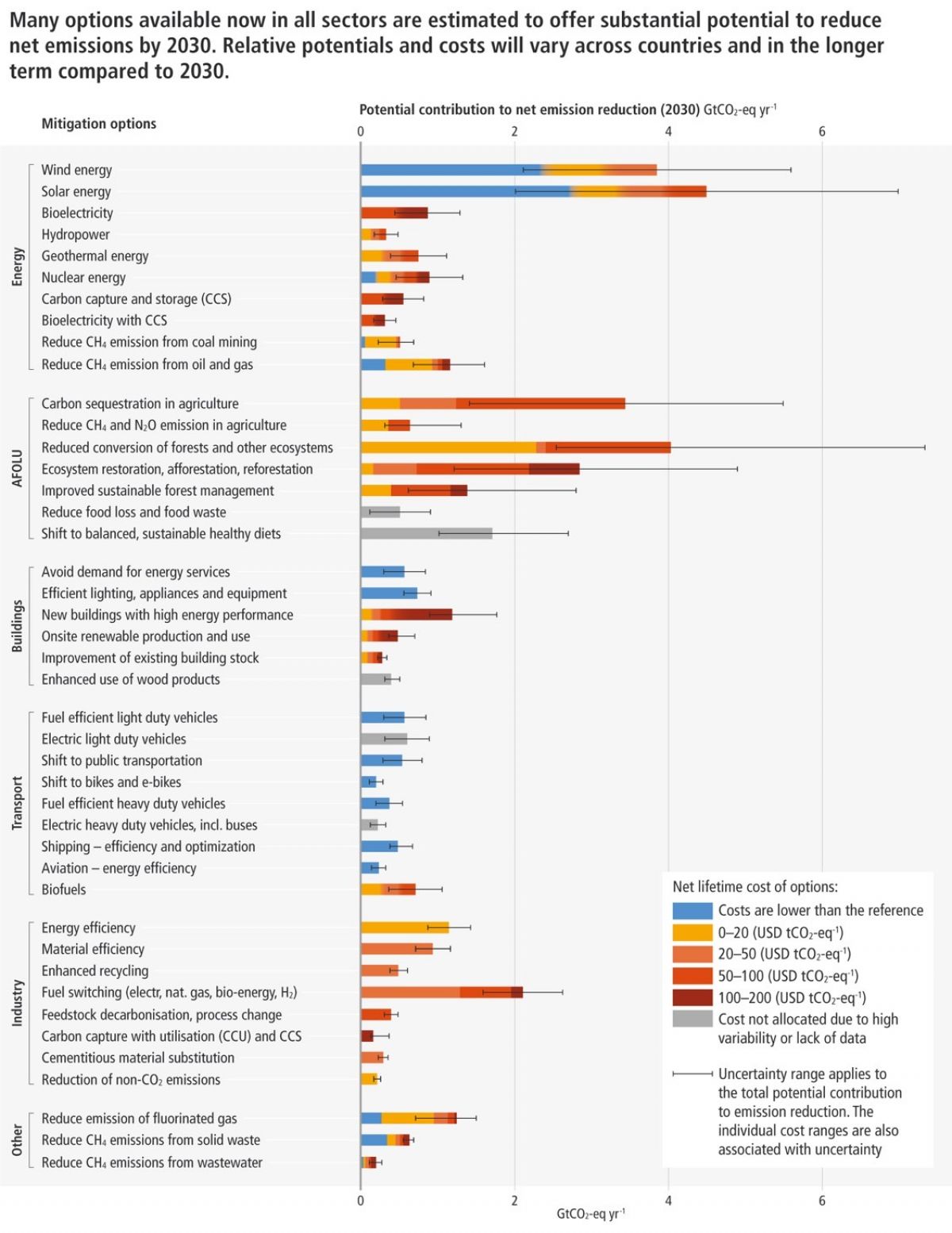
Energy
The energy sector accounts for about 1/3 of all emissions, and major transitions are required to limit global warming.
A substantial reduction in fossil fuel use, low or no carbon energy systems.
Widespread electrification.
Use of alternative fuels such as hydrogen and sustainable biofuels.
Use of carbon capture and storage and improved energy efficiency.
Transitioning to a low carbon energy sector is expected to cut down international trade in fossil fuels.
Energy efficiency and reductions in energy consumption can be achieved, which is using digital technologies.
In this way it is also possible to decentralize energy networks so that power comes from multiple localized energy networks rather than one main electricity grid.
Electricity systems powered by renewables are becoming increasingly viable. But this will be challenging to supply the entire energy system in this way.
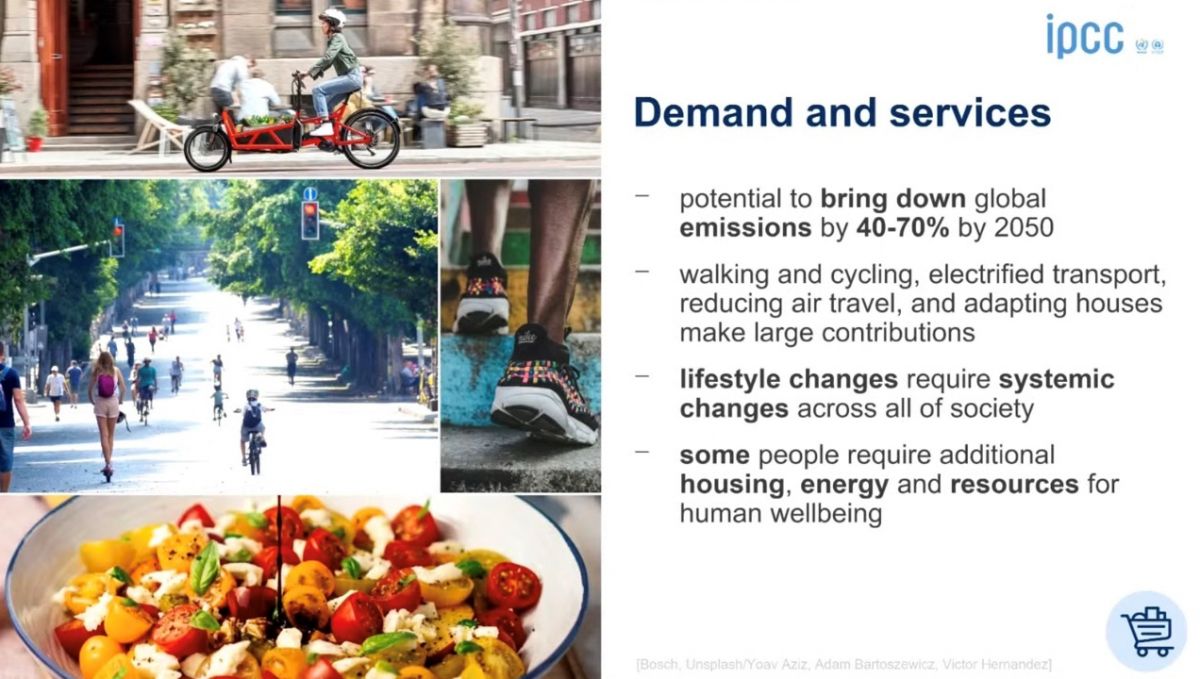
Demand and services
Changes to our lifestyle and behavior can reduce our carbon footprint as well as improve our health and well being.
There is untapped potential here to bring down global emissions by between 40% and 70% by 2050. But only if the necessary policies, infrastructure and technologies are in place.
Of the 60 actions we assessed in this report on an individual level, the biggest contribution comes from switching to walking and cycling. And using electrified transport.
Other effective options include reducing air travel. And adapting our houses. Shifting towards balanced plant based diets is an option.
Wealthier behaviors have the highest potential for reductions as investors, consumers, role models. And professional. Weather has mitigation potential in many regions of the world. In some places, people require additional housing, energy and resources for human well being.
To be effective, lifestyle changes will need to be supported by systemic changes across every aspect of society, including transport, buildings, industry and land use.
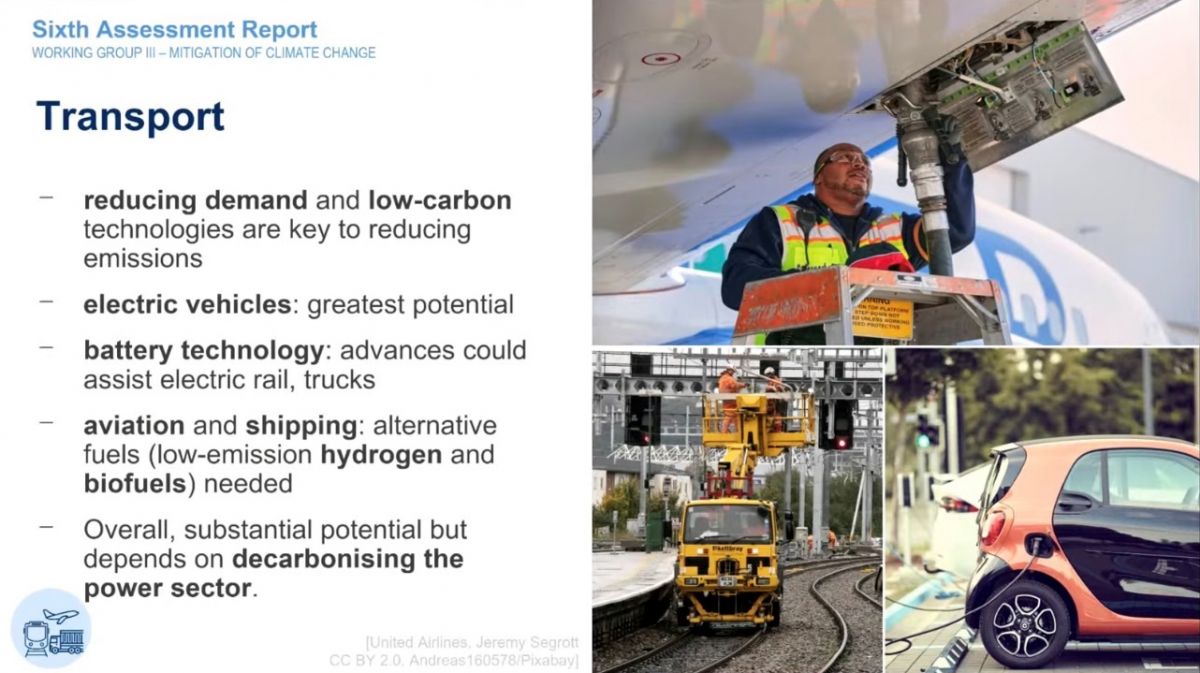 Transport
Transport
Reducing demand plays an important part in reducing emissions and low carbon technologies are also key.
Electric vehicles offer the greatest potential as long as they are combined with low or zero carbon electricity sources.
Advances in battery technologies could assist in the electrification of trucks and complement conventional electric list rail systems.
In aviation and shipping, which are harder to harmonize. Alternative fuels,such as low emission hydrogen and biofuels would be needed.
Overall, there is substantial potential for emissions reductions, but this depends on decarbonizing the power sector.
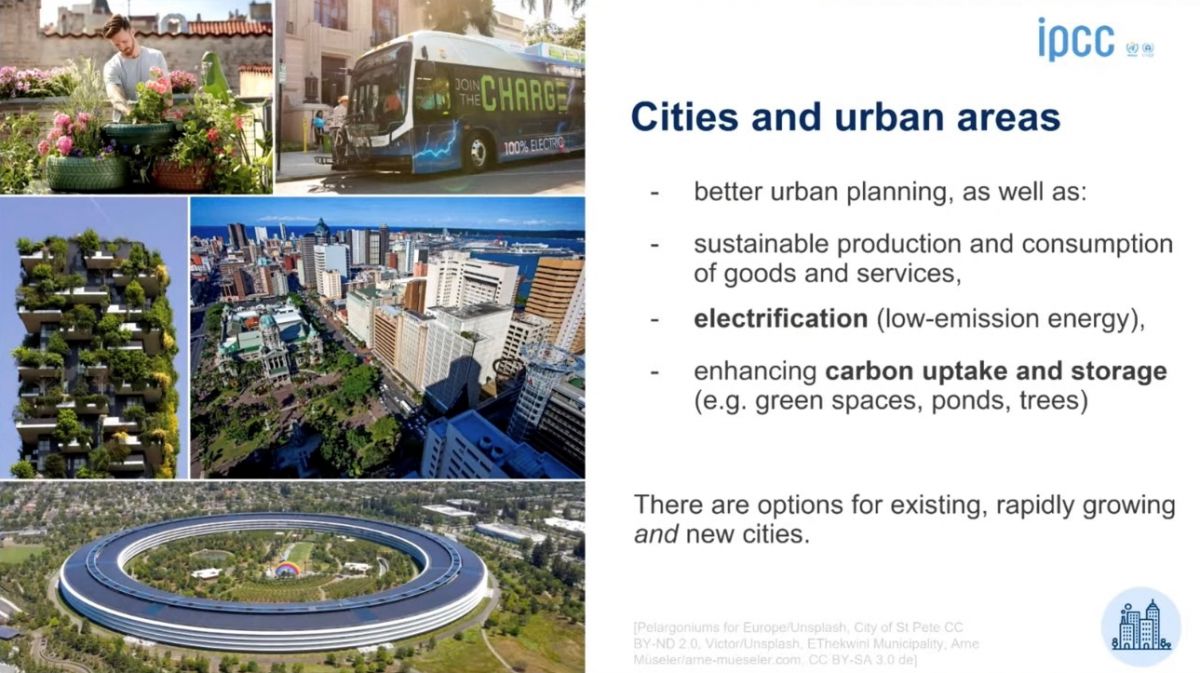
Cities and Urban areas account for more than 2/3 of global emissions. If we take into account what is produced in the city and brought in from elsewhere through energy and products. And there is significant potential for emissions reductions.
In all cities, better urban planning is key.
Three other broad strategies have been found to be effective.
These include.
Sustainable consumption and production of goods and services.
Electrification. (low carbon energy)
And improving carbon uptake and storage in cities. For example, with trees, lakes, green roofs and permeable surfaces.
Buildings
In buildings it is possible to reach net zero in 2050. Action in this decade is critical.
To fully capture this potential.This will involve retrofitting existing buildings and using effective mitigation technologies in those that are yet to be built.
This requires ambitious policy packages, which may incorporate efficient design and use of space, energy, materials, appliances, and the use of renewables.
There is an increasing number of net zero energy and net zero carbon buildings in almost all climate.This has come about from construction and retrofitting. It could be done to reduce submissions in this sector if renovation rates and retrofitting were improved.
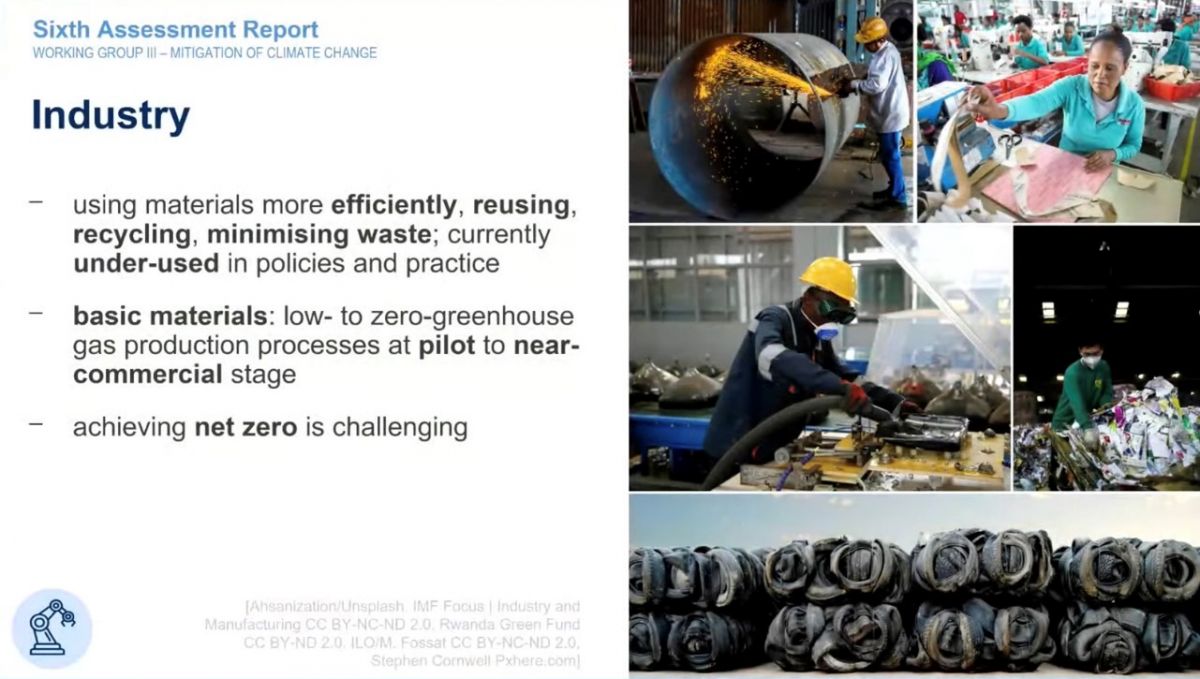
Industry
Reducing emission in industry will involve using materials and energy more efficiently, reusing and recycling products and minimizing waste.
These approaches are underused in policies and industrial practice at present.
For basic materials including steel, building materials and chemicals low to zero greenhouse gas production processes, are there pilot or near commercial stage. In some cases they are in the commercial stage but not yet established through industrial practice.
This sector accounts for about a quarter of global emissions.
Achieving net zero will be challenging.
And will require a new production process with low and zero emissions, electricity, hydrogen and where necessary, carbon capture and storage.

Carbon Dioxide Removal
Is essential to achieve net zero emissions
Remove carbon dioxide from the atmosphere and store it on land, underground or in the ocean.
There are biological methods that can store carbon. Such as reforestation and soil carbon management. These are quite wildely practical.
New technologies such as direct air capture and storage require more research, upfront investment and proof of concept at larger scales before they can be widely used.
Carbon dioxide removal is essential to achieve net zero.
For carbon dioxide removal to work effectively, agreed methods for measuring reporting and verification are required.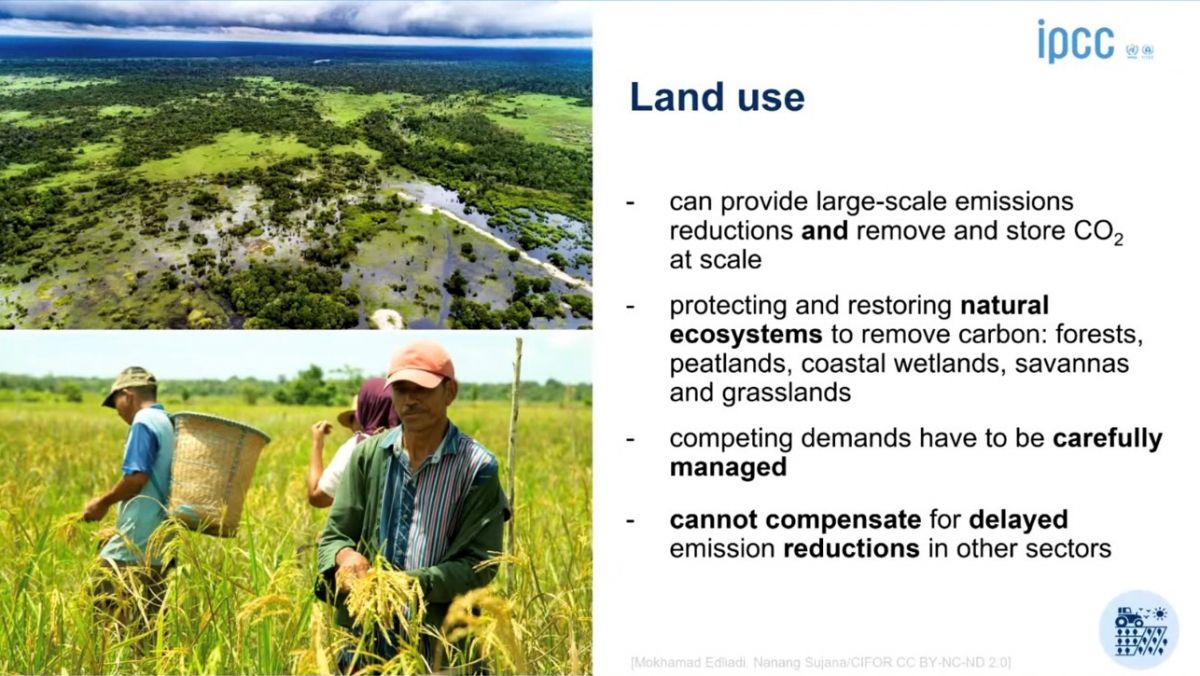
Land Use
Agriculture & Forestry, and other land use can provide large scale emissions reductions and remove and store carbon dioxide at scale.
This can be done so much. Protecting and restoring natural ecosystems, including forests, peatlands, coastal wetlands, savannas and grasslands.
Improved and sustainable crop and livestock management can also play a part.
Land provides us with so much. For example food, nature and their livelihoods.
These competing demands have to be carefully managed. But land can only do so much in terms of removing and storing carbon, and cannot compensate for delayed emission reductions in other sectors.

To limit global warming to only 2 degree C
These are precisely the ways & options, to improve on our chances to succeed.

Finance.
Financial flows are a factor of 3 - 6 times lower than levels needed by 2030, to limit warming to below 1.5 degrees Celsius, or 2 degrees Celsius. But there is sufficient global capital available in liquidity to close investment gaps. Clear signaling from the government and the international community, including a strong alignment of public sector finance and policies, is critical.
The challenge of closing gaps is widest for developing countries due to the limited capacities. Particularly the least developed countries. Without taking into account the economic benefits of reducing adaptation cost or avoiding climate impacts, global gross domestic product growth would be just a few percentage points lower in 2050. If we take the necessary actions to limit warming to 2 degrees Celsius or below, compare two maintaining current policies.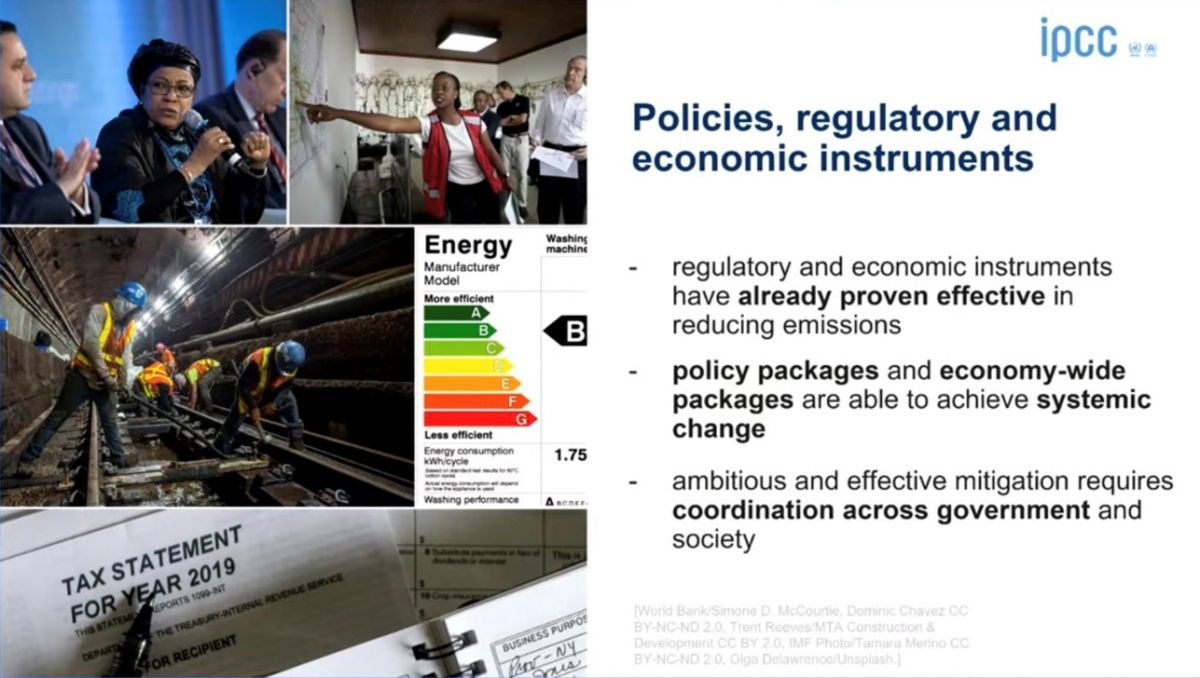
Policies, regulatory and economic instrument
a critical role in strengthening the response to climate change.
Regulatory and economic instruments ranging from standards for vehicle efficiency and building codes to policies for industrial decarbonisation. Broad based carbon taxes and emission trading systems have already proved effective in reducing emissions. Source, such measures can be strengthened and expanded significantly.
Policy packages and economy-wide packages are better able to achieve systematic change, than individual policy instruments on their own.
Ambitious and effective mitigations. Mitigation requires coordination across government settings and implementing strategies and building consensus among disparate stakeholders.
These efforts are particularly effective when built on engagement with civil societies, indigenous people, professional bodies and businesses.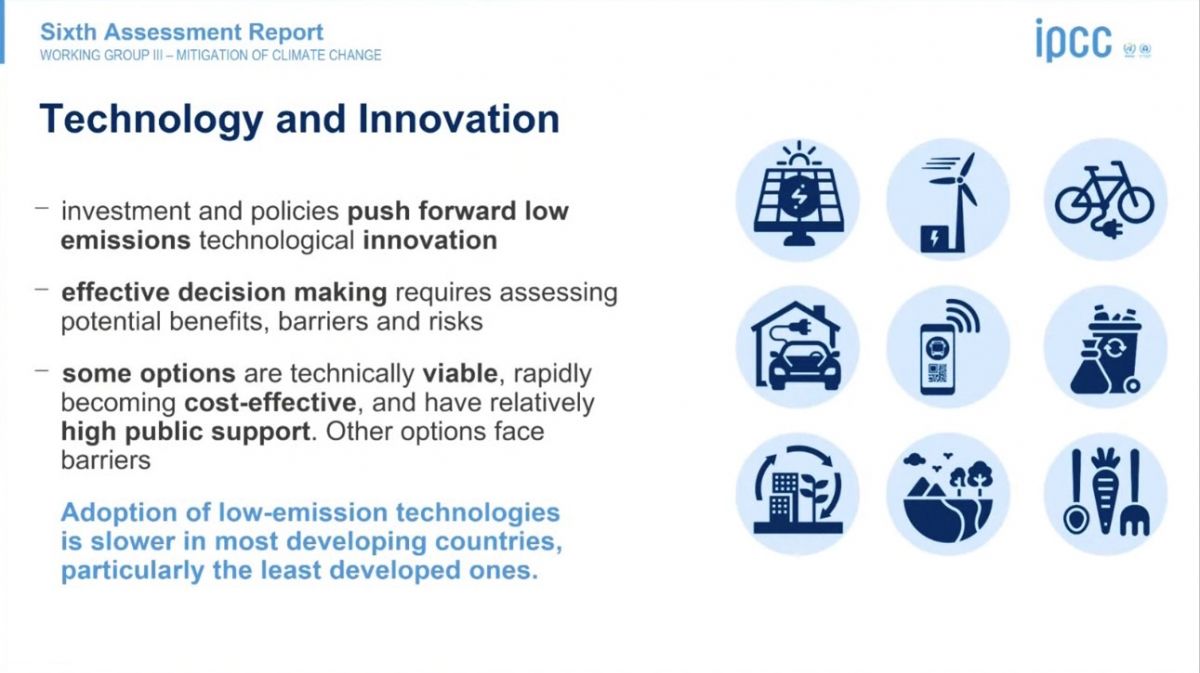
Technology and Innovation
Investment on policies, especially for scientific training as well as research and development, push forward low emission technological innovation.
Key to effective decision making in assessing the potential benefits and risks of different technologies and approaches. Understanding their implementation and scale, and identifying what stands in their way.
Some options are technically viable, increasingly cost-effective, and generally supported by the public, which enables development in many regions.
Examples include solar energy, energy efficient appliances, improving forest and crop management, and reducing food waste.
All options face barriers that need to be addressed before they can be implemented at scale.
Adoption of low emission technologies is low, and is slower in most developing countries, particularly the less developed, less developed countries due to their limited capacities.
In all countries, actions to limit global warming that result in wider benefits to society can increase the peace, depth and breadth of emission factions. Accelerated and equitable climate action in mitigating climate change and adapting to climate change impact is critical to sustainable development.
In this report, we show how mitigation goes hand in hand with achieving many other sustainable development goals.
“We need to show how mitigation goes hand in hand with achieving many sustainable development goals. We see that equity and used transitions can lead to deeper ambitions for accelerated climate action.
Many countries and regions are already applying. “Just transition principles” In our assessment, we look at how mitigation actions can lead to sustainable development. Mitigation Options
Mitigation Options
As we focus on just one option, green and blue infrastructure. We see that green roof and facade energy of parks and open space with lands and urban agriculture can only count. Not only absorb and store carbon, but at the same time achieve many other sustainable development goals.
For example, they can reduce pressure on urban server systems, reduce flood risks and heat island effects. They can also deliver health benefits from reducing air pollution.
Focusing now on land use, avoiding deforestation and sustainably managing soils, forests and livestock can mitigate climate change. These actions align well with sustainable development and can also result in responsible production, improving livelihood and food security.
Potential conflicts between reducing emissions and sustainable development, particularly around land use, and they need to ensure access to food, water and energy can be managed with the right policies, investment and financial partnerships.This gives an insight into the wider benefits of mitigation.
Our report provides a comprehensive assessment of all this.
Climate change is a result of more than a century of sustainable energy and land use, and patterns of sustainable consumption and production. What this report is done is to show how taking action now can move us towards a fairer and more livable world. And so, just to sum it all up, we know what to do.We know how to do it and now it's up to us to take action.
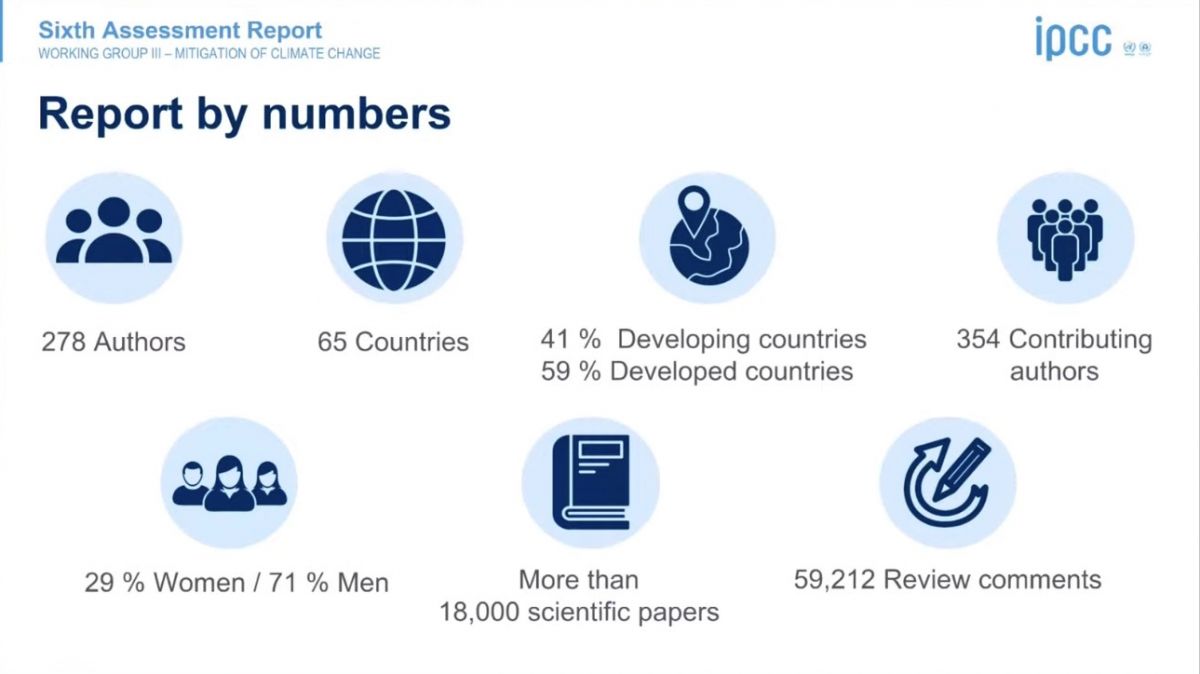
“ Absolutely makes clear that we're not talking about business as usual if we are going to address the challenge of climate change. So we just, we don't look at the immediate past and say we expect that pattern to continue. The message is very clear. The governments of the world have asked subset.Targets in the Paris Agreement or parties in the Paris goals of limiting warming to 1.5, or maybe 2 degrees, and what we have done is set out very clearly. It's almost through the laws of physics and chemistry that that is what would need to happen ”
“ If we were to limit warming to these levels. No, we're very conscious of the question about this. There's some big change of direction. So the report does contain within it lots of assessments of the feasibility of the individual options. And it also has an assessment about the feasibility of actually the kind of system changes that would be needed ”
“ And just to say, the longer we put off action in terms of addressing climate change, the bigger the feasibility challenges will be and that is a very, very clear message of the report.”









